Tom's Guide Verdict
The Volta V delivers strong gaming performance in a striking, environmentally-friendly chassis.
Pros
- +
Stylish, eco-friendly design
- +
Strong overall and graphics performance
- +
Runs very quiet
Cons
- -
Not a lot of customization
- -
4K gaming is mixed
Why you can trust Tom's Guide
At first glance, the Volta V (starting at $1,999; reviewed at $2,885) looks more hipster than gamer with its slick walnut case. But don't sleep on it — this small, environmentally-friendly PC has more than enough power to support most of your gaming, VR and productivity needs. It's a great departure for gamers who are tired of the same old flashing lights on every gaming desktop — or are just woke AF.
Design: Eco-Friendly Chic
The Volta V looks more like a miniature version of one of those swanky '60s coffee tables than a badass gaming rig — and that's the biggest part of the appeal.

Instead of delivering light shows, metal and glass, the Volta V has a case made from American hardwood (walnut, in this case), aluminum and 3D-printed steel. There is a bit of plastic in the makeup, but it's hidden from prying eyes in the interior of the case. If walnut's not your thing, you can get the system in bamboo. In short, this desktop is eco-friendly chic.
Because the paneling is made out of wood, it is prone to expanding and contracting due to moisture or dryness in its environment.. So if you were thinking about using the Volta V in a particularly humid or arid environment, you might want to reconsider.
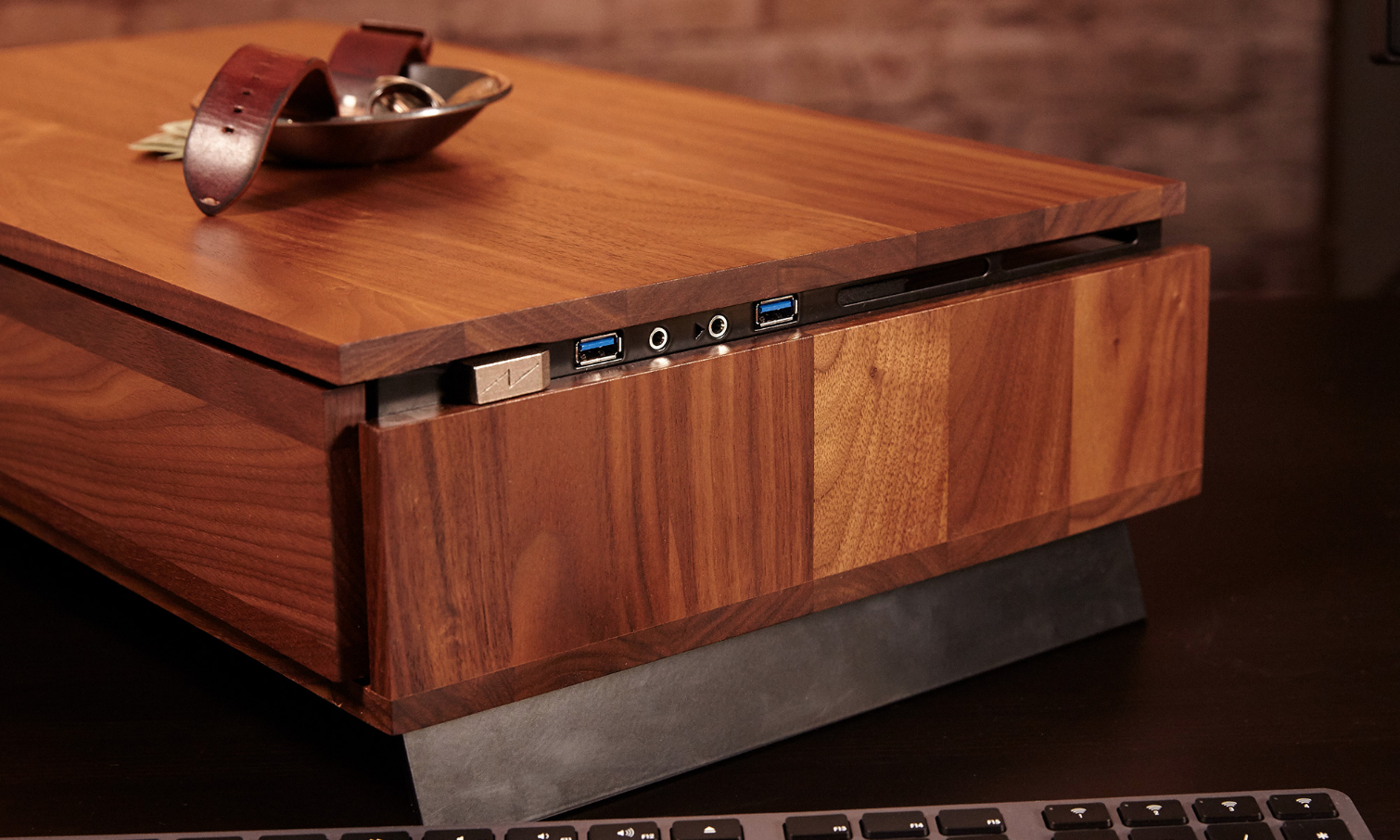
The front panel juts out slightly and reminds me of a cabinet, so much so that I tried pulling it out on several occasions. There's a small silver-aluminum lightning-bolt emblem in the lower-left corner for a nice — but not over-the-top — piece of flair. The sides and most of the rear panel are made of more luscious walnut. The bottom of the desktop is made of aluminum, with two large nylon dust filters attached via magnet.
The system stands on a pair of black aluminum feet, allowing for enough space to slide a keyboard underneath when it's not in use. The legs are sturdy enough to support a monitor up to 30 pounds placed on top of the Volta V.
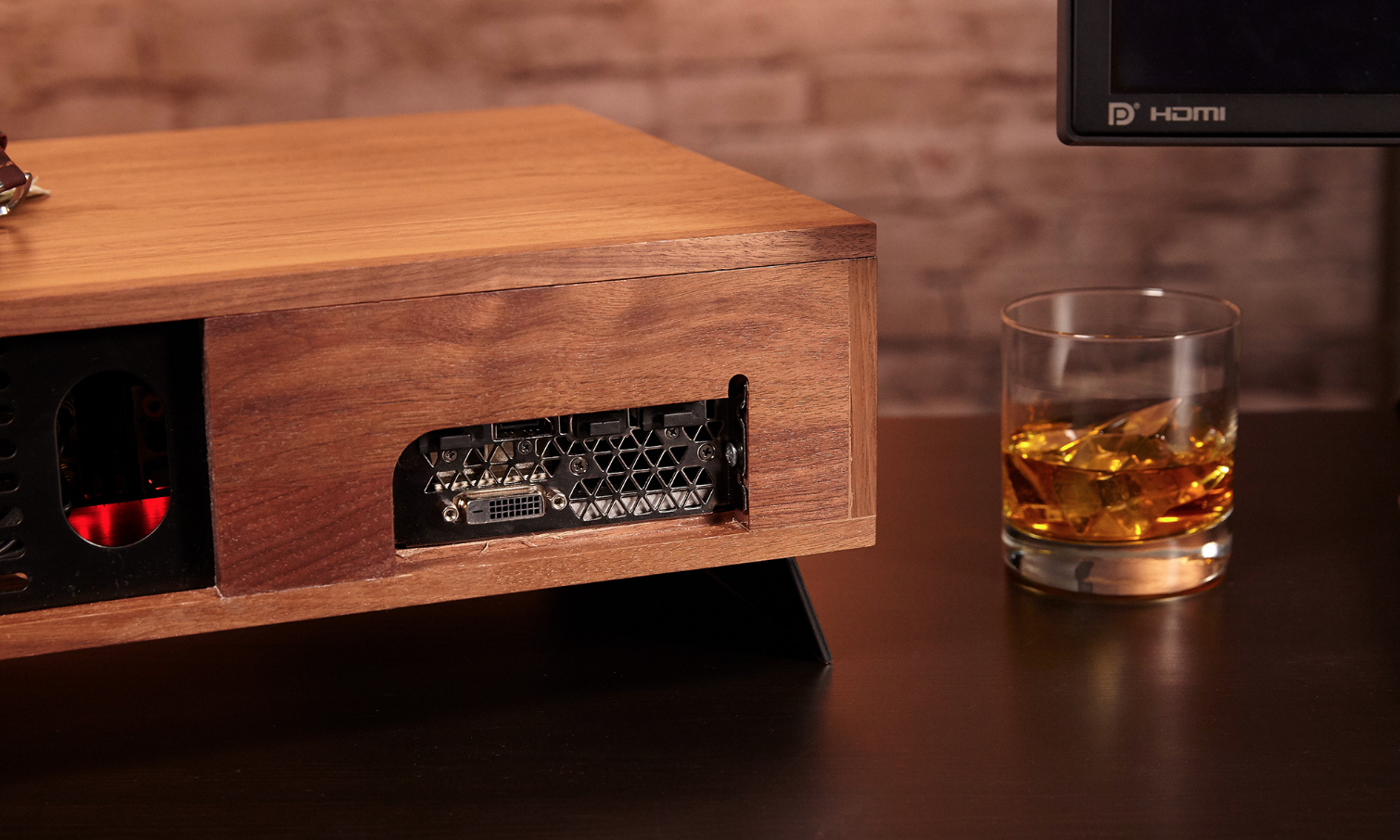
Even though I do love a hefty mid or full tower, the Volta V's slight dimensions speak to my rather small New York City apartment. At 15.8 pounds and 20.3 x 11.9 x 3.9 inches, the Volta V would look nice in a living room or on a work desk. It's thicker than the MSI Trident (7 pounds, 13.6 x 3.8 x 2.8 inches) but thinner than the Corsair One (15.8 pounds, 14.9 x 7.9 x 6.9 inches) and the Maingear Drift (35 pounds, 18.3 x 15.11 x 5.8 inches).
Ports and Upgradability: Just Pop the Top
In the interest of cord and space management, the Volta V's ports are seated deeper inside the case than I'm used to. You get four USB 3.0 ports, three USB 3.1 ports, HDMI-in and Gigabit Ethernet.
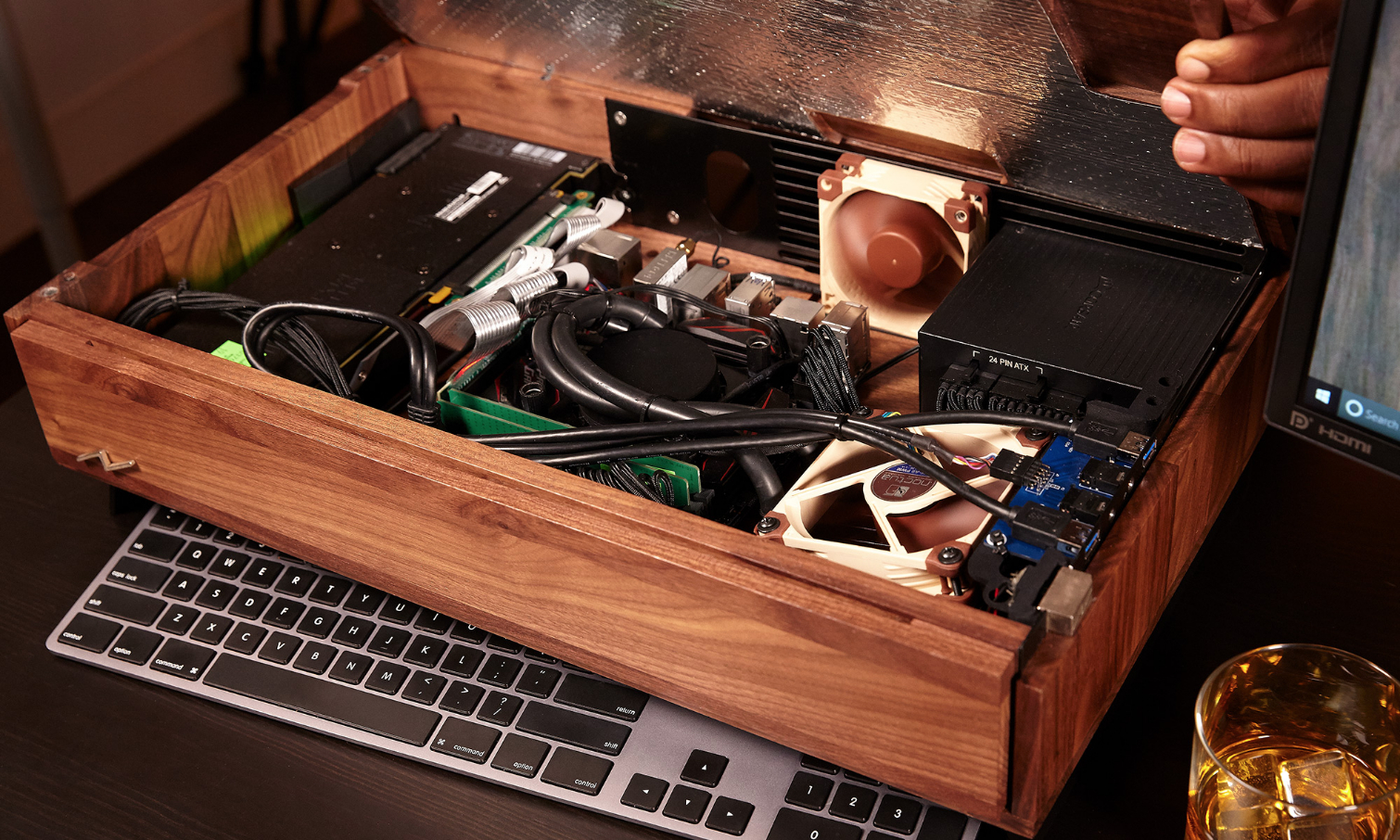
Your single GPU has its three DisplayPorts and one HDMI-out port, and there are a number of audio outputs, including headphone, microphone and the optical digital out jack. For gamers holding on to their decades-old peripherals, Volta V packs a PS/2 port.
The company also placed a couple more USB 3.0 and audio ports along the system's right, along with the silver steel power button.

To get that sweet, sweet cord management going, you're going to have to thread your peripherals into the system. Thankfully, all you have to do to access your ports (and other components) is remove the desktop's top, which I'm happy to report requires nothing more than lifting the panel from the case. From there, you can easily swap out components.
MORE: The Best Gaming Desktops Available Now
Gaming and VR Performance: Better Than Average
The Volta V is outfitted with an Nvidia GeForce GTX 1070 GPU with 8GB of VRAM, which means that it can reliably deliver great frame rates at 1080p and mixed performance at 4K. However, like its more powerful brethren, the 1070 is a beast on VR, which means you can expect a smooth gaming experience when you strap on your Oculus Rift or HTC Vive.
Even as I teleported from spot to spot, dismembering brightly colored automatons in Robo Recall, there were no nausea-inducing stutters. When we ran the SteamVR Performance test, the desktop maxed out the score at 11, matching the One (GTX 1080) and the Drift (GTX Titan X) while beating the 10.6 desktop average. The Trident and its GTX 1060 GPU produced a score of 7.3.
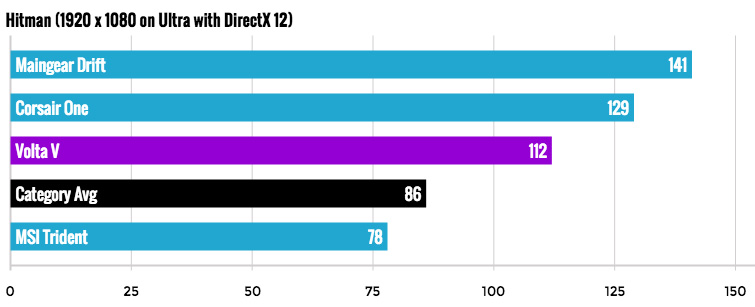
The Volta V held its own on some of our more rigorous benchmarks, putting down 112 frames per second on the Hitman test (1080p on Very High). This trounced the 86-fps average and the Trident's 78 fps. However, the Drift and the One notched higher scores of 141 fps and 129 fps, respectively, with their more powerful GPUs. The Volta V's frame rate took a big hit when we switched over to 4K (3840 x 2160), dropping to 49 fps, while the One fell to 79 fps.
When I played Mass Effect: Andromeda on Ultra at 4K, the system averaged 22 fps, which is below our 30-fps playability threshold. I managed to hit 30 fps on High and 35 fps on Medium. Compare that to the 51 fps the desktop delivered on Ultra on 1080p, and there's a clear difference.
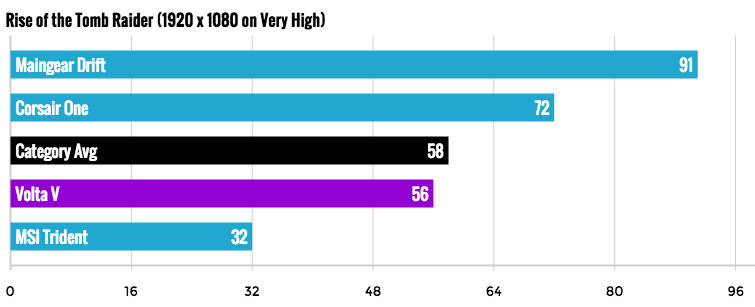
On the Rise of the Tomb Raider test, the Volta V obtained 56 fps at 1080p, which is a little short of the 58-fps average but better than the Trident's 32 fps. Meanwhile, the Drift and the One reached 91 fps and 72 fps, respectively.
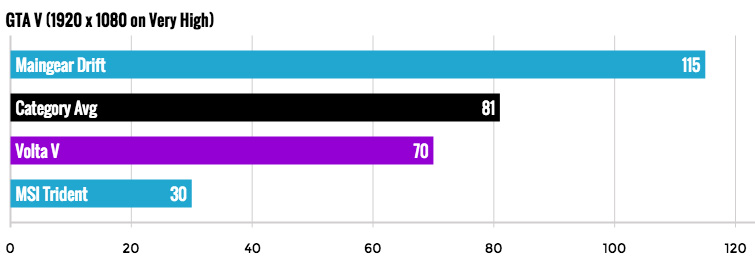
During the Grand Theft Auto V benchmark, the Volta V got 70 fps, missing the 81-fps average while dispatching the Trident's 30 fps. The Drift notched an insane 115 fps.
Overall Performance: A Speedy Powerhouse
Need to update a massive spreadsheet while watching your favorite livestream and editing a few photos? The Volta V's overclocked 4.2-GHz Intel Core i7-7700K CPU with 16GB of RAM has it covered and then some.
I actually had 40 tabs open in Google Chrome, some of which were streaming Netflix and running TweetDeck. I also started up a full system scan in Windows Defender while playing Asphalt 8 and never saw a hiccup.
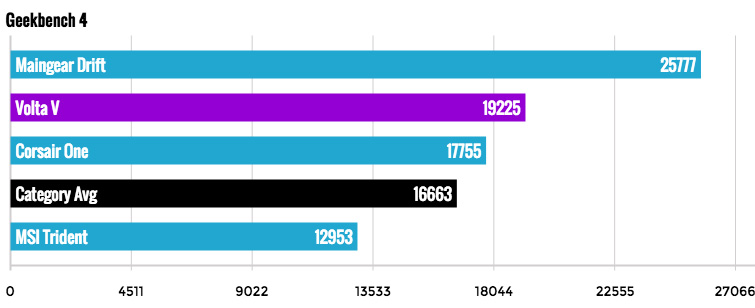
The desktop also performed well on our synthetic benchmarks, scoring 19,225 on the Geekbench 4 overall performance test and surpassing the 16,663 desktop average. The One, which also has a i7-7700K CPU, notched 17,755, while the Trident and its last-generation Intel Core i7-6700K CPU delivered 12,953. But the Drift and its overclocked Intel Core i7-6950X CPU achieved a monstrous 25,777.
When we tested the Volta's file-transfer speeds, its 512GB NVMe PCIe solid-state drive copied 4.97GB of multimedia files in 9 seconds, for a speedy 565.5 megabytes per second. That score demolished the 298.3-MBps average, and also topped the Drift (dual 250GB SSDs), the One (480GB SSD) and the Trident (128GB SSD), which produced speeds of 363.5 MBps, 236.6 MBps and 133.9 MBps, respectively.
The Volta V continued its speedy ways on the OpenOffice Spreadsheet Macro test, pairing 20,000 names and addresses in 2 minutes and 31 seconds. That's faster than the 3:18 desktop average as well as the times put up by the Trident (3:12) and the Drift (3:01).
MORE: The Best Gaming Laptops
Heat: Cool Confidence
Even when I was in the heat of battle during Mass Effect: Andromeda, the Volta V managed to stay relatively cool thanks to its liquid cooling module. After I fought Kett for 15 minutes, the rear-mounted fans blew 101 degrees Fahrenheit. That's above our 95-degree comfort threshold, but no one's going to be placing this machine on their lap. And whether I was playing a traditional game or a VR title, the fans were almost whisper quiet.
Software: Keeping It Light
The Volta V is light on bloatware, as any good desktop should be. There are a few flies in the ointment, such as Candy Crush Soda Saga, Facebook and Twitter. Nvidia GeForce Experience is the only gaming software, bundling up a bunch of gamer-focused features, such as Battery Boost and Game Optimization, into one easy spot.
The Volta V includes lifetime service and tech support and a one-year parts warranty.
Configurations
I had a great time playing with the $2,885 model of the Volta V, which has an Intel Core i7-7700K CPU with 16GB of RAM, a 512GB NVMe PCIe SSD and an Nvidia GeForce GTX 1070 GPU with 8GB of VRAM.
The $1,999 base model features a 3.0-GHz Intel core i5-7400 GPU, 8GB of RAM, a 250GB SSD and an Nvidia GeForce GTX 1050 GPU with 2GB of VRAM. For folks with deeper pockets, there's the $3,969 iteration, which has an overclocked Intel Core i7-6900K processor, 32GB of RAM, a 500GB SSD and an Nvidia GeForce GTX 1080 GPU with 8GB of VRAM.
Although the Volta V offers several customization options — including for the motherboard, type of wood, CPU and GPUs — the well isn't as deep as what boutique companies such as Maingear and Origin offer.
MORE: Our Favorite Gaming Keyboards
Bottom Line
The Volta V isn't your average desktop. Made from wood and other environmentally safe materials, the desktop PC has eco-friendly cred for days. But don't you dare write it off as a lightweight when it comes to gaming. Sporting an Nvidia GeForce GTX 1070 GPU and a powerful Core i7 processor, the Volta V lets you help save the real world at the same time you liberate virtual kingdoms and galaxies.

However, if you're looking to confidently play 4K games, you might want to step up to the $2,898 model with the Nvidia GTX 1080 GPU. And if you're looking for something a bit flashier, you might want to take a gander at the Maingear Drift, which starts at $1,299. Still, if you want a slick, retro-looking system with equally impressive power and looks (with some eco-friendliness thrown in), the Volta V deserves your attention.
Credit: Jeremy Lips/Tom's Guide
Sherri L. Smith has been cranking out product reviews for Laptopmag.com since 2011. In that time, she's reviewed more than her share of laptops, tablets, smartphones and everything in between. The resident gamer and audio junkie, Sherri was previously a managing editor for Black Web 2.0 and contributed to BET.Com and Popgadget.

